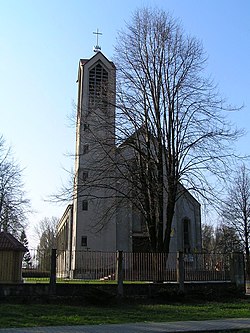| Trawniki | |
|---|---|
| Village | |
 Parish church Parish church | |
 | |
| Coordinates: 51°7′55″N 23°0′9″E / 51.13194°N 23.00250°E / 51.13194; 23.00250 | |
| Country | |
| Voivodeship | |
| County | Świdnik |
| Gmina | Trawniki |
| Population | |
| • Total | 2,893 |
| Time zone | UTC+1 (CET) |
| • Summer (DST) | UTC+2 (CEST) |
| Vehicle registration | LSW |
Trawniki is a village in Świdnik County, Lublin Voivodeship, in eastern Poland. It is the seat of the gmina (administrative district) called Gmina Trawniki. It lies approximately 24 kilometres (15 mi) south-east of Świdnik and 33 km (21 mi) south-east of the regional capital Lublin, and the river Wieprz flows by it.
History
The village was mentioned as Trawnik in a chronicle by Jan Długosz. It was administratively located in the Lublin Voivodeship in the Lesser Poland Province of the Kingdom of Poland.
During the Third Partition of Poland in 1795, Trawniki was annexed by Austria. After the Polish victory in the Austro-Polish War of 1809 it was regained by Poles and included within the short-lived Polish Duchy of Warsaw. Following the duchy's dissolution in 1815, it was part of the Russian-controlled Congress Poland, since 1837 administratively located in the Lublin Governorate. In 1827, it had a population of 240. The Russian government planned to use its train station to transport Russian troops to fight Austria-Hungary during World War I. After World War I, Poland regained independence and control of the village.
World War II

During World War II and the German occupation of Poland, Trawniki was the location of the Trawniki concentration camp. This camp provided slave labourers for nearby industrial plants of the SS Ostindustrie. They worked in appalling conditions with little food, and many died of disease, malnutrition and ill treatment.
From September 1941 until July 1944, the camp was also used for training guards recruited from Soviet POWs, who were known as "Hiwi" (German letterword for 'Hilfswillige', lit. "those willing to help"), for service with Auxiliary police in occupied Poland.
In addition to serving as guards at concentration and death camps, the Trawniki men (German: Trawnikimänner) took part in Operation Reinhard, the Nazi extermination of Polish Jews. They conducted executions at extermination camps and in Jewish ghettos, including at Belzec, Sobibor, Treblinka II, Warsaw (three times, see Stroop Report), Częstochowa, Lublin, Lwów, Radom, Kraków, Białystok (twice), Majdanek as well as Auschwitz, and Trawniki itself.
References
- "Central Statistical Office (GUS) - TERYT (National Register of Territorial Land Apportionment Journal)" (in Polish). 2008-06-01.
- ^ Słownik geograficzny Królestwa Polskiego i innych krajów słowiańskich, Tom XII (in Polish). Warszawa. 1892. p. 448.
{{cite book}}: CS1 maint: location missing publisher (link) - Stone, Norman (1975). "chapter 1". The Eastern Front 1914-1917. Penguin Books.
at Trawniki, where troops would be unloaded for the Austro-Hungarian front, twenty trains could arrive in a day, but, for lack of long platforms, only ten of them could be unloaded.
- ^ Mgr Stanisław Jabłoński (1927–2002). "Hitlerowski obóz w Trawnikach". The camp history (in Polish). Trawniki official website. Retrieved 2013-04-30.
{{cite web}}: CS1 maint: multiple names: authors list (link) CS1 maint: numeric names: authors list (link) - ^ "Trawniki". Holocaust Encyclopedia. United States Holocaust Memorial Museum. Retrieved July 21, 2011.
| Gmina Trawniki | |
|---|---|
| Seat | |
| Other villages | |